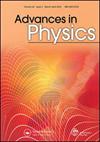The effect of collective spin-1 excitations on electronic spectra in high- Tc superconductors
IF 13.8
1区 物理与天体物理
Q1 PHYSICS, CONDENSED MATTER
引用次数: 211
Abstract
We review recent experimental and theoretical results on the interaction between single-particle excitations and collective spin excitations in the superconducting state of high-Tc cuprates. We concentrate on the traces that sharpen features in the magnetic-excitation spectrum (measured by inelastic neutron scattering) and imprint in the spectra of single-particle excitations (measured, e.g. by angle-resolved photoemission spectroscopy, tunnelling spectroscopy, and indirectly also by optical spectroscopy). The ideal object to obtain a quantitative picture for these interaction effects is a spin-1 excitation around 40 meV, termed ‘resonance mode’. Although the total weight of this spin-1 excitation is small, the confinement of its weight to a rather narrow momentum region around the antiferromagnetic wavevector makes it possible to observe strong self-energy effects in parts of the electronic Brillouin zone. Notably, the sharpness of the magnetic excitation in energy has allowed these self-energy effects to be traced in the single-particle spectrum rather precisely. Namely, the doping and temperature dependence together with the characteristic energy and momentum behaviour of the resonance mode has been used as a tool to examine the corresponding self-energy effects in the dispersion and in the spectral line-shape of the single-particle spectra, and to separate them from similar effects due to the electron–phonon interaction. This leads to the unique possibility to single out the self-energy effects due to the spin–fermion interaction and to directly determine the strength of this interaction in high-Tc cuprate superconductors. The knowledge of this interaction is important for the interpretation of other experimental results as well as for the quest for the still unknown pairing mechanism in these interesting superconducting materials. Contents PAGE 1. Introduction 49 2. Experimental evidence of a sharp collective spin excitation and its coupling tofermions 52 2.1. Inelastic neutron scattering 52 2.1.1. Magnetic coupling 53 2.1.2. The magnetic resonance feature 54 2.1.3. Bilayer effects 56 2.1.4. Temperature dependence 58 2.1.5. Doping dependence 60 2.1.6. Dependence on disorder 60 2.1.7. Isotope effect 62 2.1.8. Dependence on magnetic field 62 2.1.9. The incommensurate part of the spectrum 63 2.1.10. The spin-gap 65 2.1.11. The spin fluctuation continuum 65 2.1.12. Normal state spin susceptibility 66 2.2. Angle-resolved photoemission 67 2.2.1. Fermi surface 67 2.2.2. Normal-state dispersion and the flat-band region 69 2.2.3. MDC and EDC 71 2.2.4. Bilayer splitting 73 2.2.5. Superconducting coherence 74 2.2.6. EDC-derived dispersion anomalies 75 2.2.7. The S-shaped MDC-dispersion anomaly 79 2.2.8. The nodal kink 81 2.2.9. Fermi velocity 82 2.2.10. Spectral line-shape 85 2.2.11. The antinodal quasiparticle peak 87 2.2.12. The spectral dip feature 90 2.2.13. Real part of self-energy: renormalization of dispersion 91 2.2.14. Imaginary part of self-energy: quasiparticle lifetime 96 2.2.15. Isotope effect 100 2.2.16. Relation to pseudogap phase 102 2.3. C-axis tunnelling spectroscopy 103 2.4. Optical spectroscopy 105 3. The collective mode as spin-1 exciton 108 3.1. Theoretical models 108 3.2. Characteristic energies 109 3.3. The resonance mode 112 3.3.1. Development of spin exciton 112 3.3.2. Doping dependence 113 3.3.3 Dependence on disorder. 115 3.3.4. Dependence on magnetic field 115 3.3.5. Even and odd mode in bilayer cuprates 118 3.4. The incommensurate response 118 3.5. Effective low-energy theories 119 3.6. Magnetic coherence in La2−xSr x CuO4 123 4. Coupling of quasiparticles to the magnetic resonance mode 124 4.1. The coupling constant and the weight of the spin resonance 126 4.2. Theoretical model 131 4.2.1. Tight binding fit to normal state dispersion 131 4.2.2. Model spectrum and basic equations 134 4.3. Contribution from the spin fluctuation mode 138 4.3.1. Characteristic electronic scattering processes 139 4.3.2. Electronic self-energy 141 4.3.3. Renormalization function and quasiparticle scattering rate 142 4.3.4. Spectral functions at the M point 144 4.4. Contribution of the spin fluctuation continuum 145 4.5. Renormalization of EDC and MDC dispersions 147 4.6. Bilayer splitting 154 4.7. Tunnelling spectra 161 4.8. Doping dependence 164 5. Discussion of phonon effects 167 6. Open problems 169 7. Conclusions 171 Acknowledgements 173 References 173集体自旋-1激励对高温超导体电子能谱的影响
本文综述了高温铜酸盐超导态中单粒子激发与集体自旋激发相互作用的实验和理论结果。我们专注于在磁激发光谱(通过非弹性中子散射测量)和单粒子激发光谱(例如通过角分辨光发射光谱,隧道光谱和间接也通过光谱学测量)中锐化特征的痕迹。获得这些相互作用效应的定量图像的理想对象是大约40兆电子伏的自旋1激励,称为“共振模式”。虽然这个自旋-1激发的总重量很小,但它的重量被限制在反铁磁波矢量周围一个相当狭窄的动量区域,这使得在电子布里渊区的部分区域观察到强的自能效应成为可能。值得注意的是,能量中磁激发的锐度使得这些自能效应在单粒子谱中可以相当精确地追踪。也就是说,利用掺杂和温度依赖以及共振模式的特征能量和动量行为作为工具,研究了单粒子光谱的色散和谱线形中相应的自能效应,并将它们与电子-声子相互作用引起的类似效应区分开来。这导致了独特的可能性,以挑选出自旋费米子相互作用的自能效应,并直接确定在高tc铜超导体中这种相互作用的强度。这种相互作用的知识对于解释其他实验结果以及探索这些有趣的超导材料中仍然未知的配对机制是重要的。第1页。2.引言尖锐集体自旋激发及其与费米子耦合的实验证据。非弹性中子散射52磁耦合53 2.1.2。磁共振特征54 2.1.3。双层效果56 2.1.4。温度依赖性58 2.1.5。兴奋剂依赖性60 2.1.6。对障碍的依赖60 2.1.7同位素效应62 2.1.8。对磁场的依赖62频谱63 2.1.10的不适应部分。自旋间隙65 2.1.11。自旋涨落连续体65 2.1.12。正常状态自旋磁化率66。角分辨光发射67 2.2.1。费米面67 2.2.2。正常状态色散和平带区域69 2.2.3。MDC和EDC 71 2.2.4。双层分裂73 2.2.5。超导相干性74 2.2.6。edc衍生色散异常75 2.2.7。s形mdc弥散异常79 2.2.8。节点扭结81 2.2.9。费米速度82 2.2.10。谱线形状85 2.2.11。反偶极准粒子峰87 2.2.12。光谱倾角特征90 2.2.13。自能实部:色散91的重整化2.2.14。自能虚部:准粒子寿命96 2.2.15。同位素效应100 2.2.16。与赝隙相102的关系c轴隧穿光谱103光学光谱学集体模式为自旋为1的激子108 3.1。理论模型108特征能量109共振模式112 3.3.1。自旋激子112的发展3.3.2。3.3.3对紊乱的依赖。3.3.4 115。对磁场的依赖115 3.3.5双层铜的奇偶模式为118 3.4。不相称反应118 3.5。有效低能理论119La2−xSr x cuo4123的磁相干性准粒子与磁共振模式124的耦合耦合常数和自旋共振的质量126 4.2。理论模型131 4.2.1。紧密结合符合正常状态色散131 4.2.2。模型谱和基本方程134自旋涨落模式的贡献138 4.3.1。特征电子散射过程139 4.3.2。4.3.3.电子自能141重整化函数和准粒子散射率142 4.3.4。M点144处的谱函数自旋涨落连续统的贡献145 4.5。EDC和MDC分散体的重整化147 4.6。双层分裂154 4.7。隧穿光谱161兴奋剂依赖164声子效应的讨论[j]。开放问题169 7。结论171致谢173参考文献173
本文章由计算机程序翻译,如有差异,请以英文原文为准。
求助全文
约1分钟内获得全文
求助全文
来源期刊

Advances in Physics
物理-物理:凝聚态物理
CiteScore
67.60
自引率
0.00%
发文量
1
期刊介绍:
Advances in Physics publishes authoritative critical reviews by experts on topics of interest and importance to condensed matter physicists. It is intended for motivated readers with a basic knowledge of the journal’s field and aims to draw out the salient points of a reviewed subject from the perspective of the author. The journal''s scope includes condensed matter physics and statistical mechanics: broadly defined to include the overlap with quantum information, cold atoms, soft matter physics and biophysics. Readership: Physicists, materials scientists and physical chemists in universities, industry and research institutes.
 求助内容:
求助内容: 应助结果提醒方式:
应助结果提醒方式:


